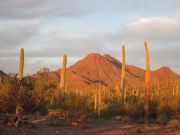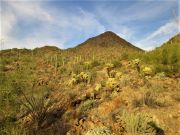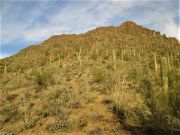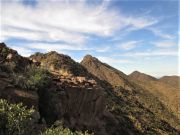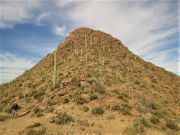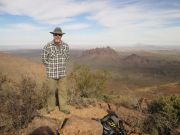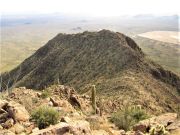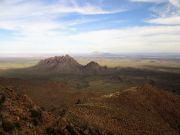
The Mountains of Arizona
• www.surgent.net
|
| Silver Bell Peak |
• Highpoint: Silver Bell Mountains • Highpoint: Ironwood Forest National Monument • Pima County |
|
Date: December 30, 2016
• Elevation: 4,261 feet
• Prominence: 1,921 feet
• Distance: 6.2 miles
• Time: 7 hours and 30 minutes
• Gain: 2,320 feet
• Conditions: Cool with high clouds and periods of sun
• Teammates: Scott Peavy & Matthias Stender
Silver Bell Peak is the highest point of the Silver Bell Mountains, about 30 miles northwest of Tucson. The Silver Bell Copper Mine abuts the range to the southwest, with access to the range (and the mine) via Avra Valley Road off Interstate-10. The peak is also the highest point in the Ironwood Forest National Monument. Scott Peavy, Matthias Stender and I would team up to climb this peak. It was the first time in almost a year the three of us climbed as a trio.
We met at Matthias' place and drove (Scott driving) to the trailhead, timing our arrival so that we'd be here as the sun was rising. The trailhead is a "guzzler" at the end of a desert track about three miles north of (and parallel to) Avra Valley Road. The desert tracks were in good shape, and we parked in a clearing at elevation 2,320 feet, about a mile short of the end of the road. The day was cool and a little cloudy, but calm. We started the actual hike at 7:50 a.m..
We walked west along the road to the guzzler, a fenced-in water catchment for the animals. Past the guzzler, we continued west about another mile hiking along gentle ridges, aiming for a low ridge ahead of us, the peak up and to our right. The brush was thick at times, with palo verde, ironwood and ocotillo, and cholla, barrel and other forms of cactus. Sometimes, we would hop into and out of gullies to get to "better looking" ridges. Eventually, we reached the far ridge and hiked up to its crest, a gain of about 700 feet from the car. We had been hiking about an hour.
At the low ridge, we studied the mountain for ways up. The top was a ridge of rock with some low points, the actual summit invisible for now. It all looked about the same, so we followed a slope that led upwards toward a lowpoint in the ridge, near the ridge's eastern tip. This slope was steep and gained about 800 feet. Much of it was covered in saguaro and other brush, plus sections of talus. The going here was slow because the talus was not always solid. It seemed that every fifth rock moved or slid. Soon, we were at the top of this slope, now on the ridge. The summit was now visible, but about three false summits lie between us and the top.
(The topographical map is not too revealing. It shows the ridge with a few symmetric ovals, which would lead one to think the slopes are smooth and consistent. Furthermore, there is an error in which the contour elevations do not line up correctly—a 3600-foot contour should be relabeled a 3500-foot contour. In this case, a map isn't vital. You can see the route the whole way and logic out those parts you can't see.)
The rocky ridge was not difficult, but it was tedious. We would gain and drop twenty to fifty feet at a time. One "summit" had a rock painted by a visitor, dating to 1972, which begged two questions—why did they stop here and not the summit, and why did they happen to have paint with them? A little later, we came to the highest point of this ridge, on which sat a cairn. From here, we dropped about a hundred feet to the saddle below. We usually stayed high on this ridge, going up and down rather than dealing with sidehilling.
The summit pyramid stood about 300 feet above us, with no obvious way up. However, the rock was fractured the same way as the previous ridge, so we followed what looked like the lines of easiest ascent, and in about fifteen minutes had arrived onto the top. The climb had taken 3 hours. There were no tricky parts on this last ascent, nothing that would rate Class-3.
We took a half-hour break up top. The day was cloudy, but now, we had a period of sun, with a steady breeze. We could look down onto the big Silver Bell Mine and even hear horns and what sounded like small explosions coming from down there. We had decent views of the surrounding mountains, the best one looking northeast at Ragged Top, Picacho Peak and Newman Peak. The big peaks near Tucson were clouded over. Looking south, Baboquivari Peak stood between Coyote and Kitt Peaks, but the haze was thick in that direction.
We could not locate the register at first, and we didn't think there was one, but then we found it, well-hidden under a clump of rocks. It seemed too well hidden. We were the first to sign in since 2014, but I know we weren't the first to visit here since then. The log went back nearly 30 years, a few visitors a year, many we know personally.
Going down, we had the advantage of gravity and took those rocky sections slowly. Back on the ridge, we were moving carefully. Matthias twisted his ankle badly at one point. Fortunately, it was not broken. I had some trainer's tape in my pack, so I wrapped it for stability. It was painful, but he was able to gut through the worst parts and slowly make his way past the ridge.
The big descent down the talus and saguaro ramp took awhile. We tried to scout a path that would allow Matthias to move easily, without having to put undue strain on his ankle. The talus slopes were both a boon and a curse --- if the rocks were solid, we could all move through them efficiently, usually with the five-points-of-contact technique. When the rocks moved or slid or groaned, we would stop and make triple sure we could get past these big ones, while allowing the adrenaline to taper off. This section would go slowly no matter the situation. There was just no fast way to get through.
Once back on lower ground, the slopes were much gentler. We followed whatever open lanes we found. It was brushier down low. All the rock-hopping, hoisting, bending over to get hand holds had made this a much more tiring hike than the statistics would indicate. We were back to Scott's vehicle at 3 p.m., a three hour and thirty minute descent. Matthias was moving well. Hopefully, the strain is not severe. The drive home went well, and I was home by 6:30 p.m., two gyros in a paper bag as my quarry.
This was a good peak on which to end 2016. It looks quick and straightforward on the map, but the loose slopes and the rocky ridge can slow one down. There's nothing technical about this peak. It may be possible to take a different route that gets one to the main saddle avoiding the rocky ridge, but that may require more walking across desert, and looking down those slopes, they did not look friendly. Thanks again to Matthias and Scott for the company.
|
|
